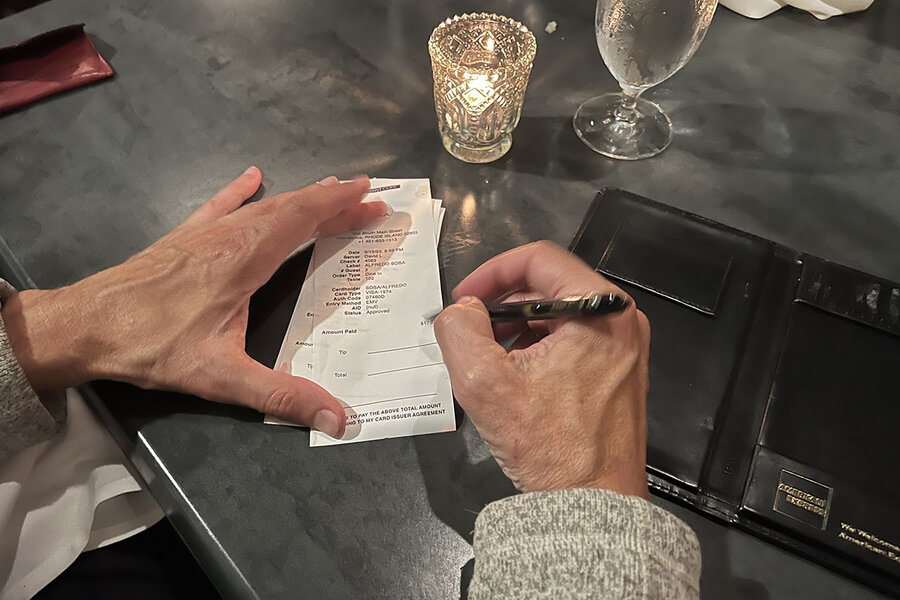Why ‘out of control’ tipping persists – for now
Loading...
| Bakersfield, Calif.
Many consumers are feeling a double punch: squeezed by inflation and overwhelmed by near-ubiquitous tip requests known as “tip creep,” driven largely by electronic payments and the ease of requesting a tip. In a recent survey by Bankrate, two-thirds of Americans had a negative view of tipping and nearly one-third said tipping culture is “out of control.”
Customers are pushing back. The frequency of tipping has declined since 2019. For instance, those who say they always tip servers in a sit-down restaurant has dropped 12 percentage points. There are also measurable drops in how often customers tip hairstylists and taxi drivers.
Why We Wrote This
A story focused onSurveys show Americans are souring on tipping, especially as technology permits more frequent requests. Consumers feel pinched, yet conflicted over how best to support service workers.
Those percentages dip even more when focused on Generation Z and millennials. “A lot of people, especially young adults, say, ‘It’s not fair. We’d rather just pay higher prices. Let’s do away with the whole tipping thing,’” says Ted Rossman, senior industry analyst for Bankrate, a financial comparison website.
Alex Ellsworth, from San Francisco, would prefer pricing that does away with a gratuity. But peer pressure and habit are strong reasons to keep tipping, and he’s unlikely to stop unless the option disappears. “If we’re given permission not to [tip], we’ll be like, ‘Hey, that’s liberating.’ But if we are pressured to, then we’ll keep doing it.”
Alex Ellsworth planned for a special night out in San Francisco with his boyfriend. The restaurant he chose was a splurge, but the self-proclaimed foodie decided it was worth it. With a $70-per-person prix fixe meal, he thought he could control the budget – they refrained from ordering drinks and were careful about other add-ons.
Then the check came: In addition to tax, the restaurant tacked on a 20% service fee, plus 5% that goes toward health care for uninsured city residents. But with a tip section still on the receipt, Mr. Ellsworth felt compelled to tip. “I really felt sadness and regret as I filled in the receipt with a tip that was equivalent to my weekly food budget,” he says. He spent $100 more than he’d expected.
His experience is not unique. Surcharges have become common in restaurants, even with gratuities still expected. Electronics have also made it easier to request tips, which are popping up in fast-food restaurants, retail, and some places with self-service. The combination of increased costs and frequency is irking consumers.
Why We Wrote This
A story focused onSurveys show Americans are souring on tipping, especially as technology permits more frequent requests. Consumers feel pinched, yet conflicted over how best to support service workers.
Tipping persists despite the social inequities and economic insecurities it reinforces; at the same time, wage models are shifting as more states increase the minimum wage. “Writ large, this is exposing ... just how absurd tipping is and how we all try to rationalize it as money provided on a variable scale based on the service we’ve received,” says sociologist Eli Wilson at the University of New Mexico. “Increasingly we’re seeing how much that logic no longer flies, in the spread of ways that consumers are being asked to tip and who they’re being asked [to tip].”
Pushing back
Many consumers are feeling a double punch: squeezed by inflation and overwhelmed by near-ubiquitous tip requests known as “tip creep,” which is driven largely by electronic payments and the ease of requesting a tip. In a recent survey by Bankrate, two-thirds of Americans had a negative view of tipping and nearly one-third said tipping culture is “out of control.”
Customers are pushing back. The frequency of tipping has declined since 2019. For instance, those who say they always tip servers in a sit-down restaurant has dropped 12 percentage points. There are also measurable drops in how often customers tip hairstylists, taxi drivers, and other service providers.
Those percentages dip even more when focused on Generation Z and millennials, who, according to research, are turned off by tipping’s inequities. “A lot of people, especially young adults, say, ‘It’s not fair. We’d rather just pay higher prices. Let’s do away with the whole tipping thing,’” says Ted Rossman, senior industry analyst for Bankrate, a financial comparison website.
The job isn’t worth doing without tips, according to some servers. “I don’t think most people would be servers. For sure,” says Julia, a server at a diner in Bakersfield, California, who declined to give her last name. “Servers don’t work 9-to-5 jobs,” she adds. “The tips are what make up for the rest of that.”
Tip percentages have risen over the last century. In the early 1900s, tip norms in restaurants and bars were 10% to 12%. Today, industry expectations are around 20% – although less than half of U.S. adults say they typically tip that much. “The recommendation and the action tend to be different,” says Mr. Rossman. “So I think that there is this pushback.”
Recently, customers have been annoyed by suggested-tip screens popping up in places where tips weren’t previously considered, like retail shops and online stores – sometimes suggesting tips as high as 35%. Starbucks made headlines last year when it rolled out tip screens for credit card transactions.
Tipping prompts will likely continue for the near future, experts say, as long as too many customers aren’t driven off.
Worker and employer interests “align here in seeing if they can get consumers to pay out a little bit more in gratuities,” says Professor Wilson, author of “Front of the House, Back of the House: Race and Inequality in the Lives of Restaurant Workers.”
Even if only half of customers are tipping, that still adds up to a lot, points out Mr. Rossman. “Customers may grumble, but if they’re not going to change their behavior and they’re not going to spend less ... we’re going to see more of this.”
Problematic then and now
Tipping as we know it in America normalized in the 20th century. Its roots go back at least 100 years earlier (some trace it to medieval times), when wealthy European clients would pass on small amounts of money to much poorer workers providing personal services. Even then, the arrangement was uncomfortable for some.
“It’s pretty much born out of unequal hierarchical social relations,” says Professor Wilson. When brought to America, tipping was viewed as undemocratic, and because of that “there was very, very strong resistance to tipping in the late 1800s and early 1900s.”
After the Civil War, American businesses like The Pullman Co. encouraged tipping to offset low wages. In Pullman’s case those workers were porters, many of whom had been previously enslaved. “They could pay them less and basically just hope that customers make up the difference,” says Mr. Rossman.
Today, tipping is entrenched in the wage model for certain services where transactions are based on human connection. “It has to do with creating an atmosphere where the guest or the consumer feels that the employee deserves it,” says Hicham Jaddoud, a hospitality and tourism professor at the University of Southern California.
Estimates place the number of tipped workers in the United States above 5 million. More than three-fourths are in the food industry; the rest are distributed among other services. Anyone whose occupation brings in at least $30 a month in tips qualifies as a tipped employee – and qualifies to make a tipped wage, which varies wildly from state to state.
The federal tipped wage – the minimum wage for tipped workers – is $2.13 an hour, where it’s been since 1996. Tips are earned on top of that. Fifteen states adhere to that minimum, but most states have raised it. Some add a few cents an hour, while a handful of states require employers to pay tipped workers a full minimum wage.
Those wage disparities reflect the varied power of workers across the country. “If you go to the Midwest, you will be surprised how low wages are versus California or even Texas,” says Dr. Jaddoud. “It all has to do with the state, the bargaining power, and how short staffing-wise that state is and how powerful the unions are.”
Rewarding a human connection
The service element is what customers are missing in transactions limited to takeout, retail, or online ordering – and that’s reflected in lower and less frequent tips.
In restaurants, where servers spend an hour or longer engaging with clients, or in salons or hotels where employees have highly personal interactions with customers, tips not only relieve the employer’s wage burden, but also incentivize workers with potential earnings.
That’s the case at Mamma Mia, a high-end restaurant in Bakersfield. Owner Bruno Garcia – who worked his way up in the industry, starting as a busboy – believes the tip system benefits everyone. Servers can make more money by providing excellent service, and clients enjoy that better service. “The tip is voluntary, and the customers ... will tip you depending on the effort.”
Level of service provided is the sole criterion for Jennifer when she leaves tips. “I think that’s the only way,” says the Bakersfield salon manager, who declined to give a last name. Tipped occupations are a lifestyle choice and “at the end of the day, it’s their decision to stay in that position.”
Ending tipping?
A movement to eliminate tipping in favor of higher hourly wages has some support, but experiments to do that have yet to prove successful. So far, most consumers haven’t shown willingness to pay higher sticker prices, even when they know it includes tips and fees.
Prices are more palatable when customers see the portion that goes to an employee. If prices do go up, customers want added value.
Mr. Ellsworth feels the pinch from inflation and California’s high cost of living. He also understands the importance of tips to low-wage workers: He previously worked as a hotel desk agent in Texas. Yet in San Francisco, where the minimum wage for everyone is over $18, tipping feels harder to justify on his tight budget, especially when he eats cereal every weekday so he can afford to go out on weekends.
Mr. Ellsworth would prefer straightforward pricing that does away with a gratuity. But peer pressure and habit are strong reasons to keep tipping, and he’s unlikely to stop unless the option disappears.
“[Customers] don’t want to be seen as awful people,” he says. “And so if we’re given permission not to, we’ll be like, ‘Hey, that’s liberating.’ But if we are pressured to, then we’ll keep doing it.”










